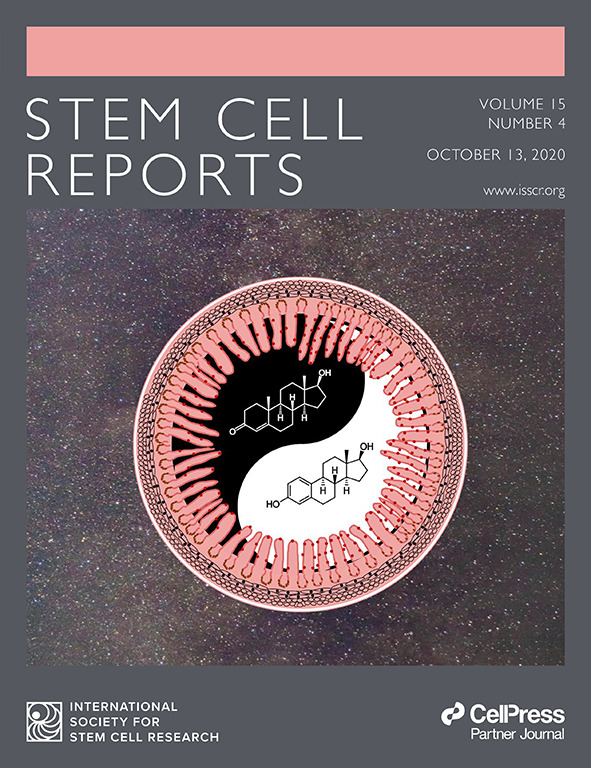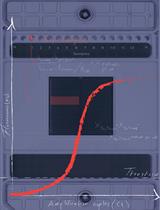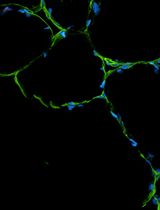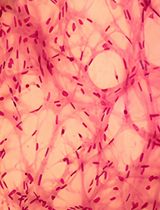- EN - English
- CN - 中文
An in vitro Mechanical Damage Model of Isolated Myofibers in a Floating Culture Condition
漂浮培养条件下离体肌纤维的体外机械损伤模型
发布: 2022年01月05日第12卷第1期 DOI: 10.21769/BioProtoc.4280 浏览次数: 3189
评审: Giusy TornilloSourav S PatnaikAnonymous reviewer(s)
Abstract
Muscle stem cells (satellite cells), located on the surface of myofibers, are rapidly activated from a quiescent state following skeletal muscle injury. Although satellite cell activation is an initial step in muscle regeneration, the stimulation of satellite cell activation by muscle injury remains to be elucidated. We recently established an in vitro mechanical damage model of myofibers, to analyze quiescent and activated satellite cells associated with myofibers isolated from the extensor digitorum longus muscle in mice. Here, we described a protocol for the mechanical damage of myofibers and co-culture of intact healthy myofibers with damaged myofibers in a floating condition. This in vitro myofiber damage model allowed us to investigate the mechanism of satellite cell activation without contamination by interstitial cells, such as blood vessel cells and fibroblasts, as well as understand how damaged myofiber-derived factors (DMDFs) activate satellite cells.
Background
Muscle stem cells called satellite cells reside between the plasmalemma of myofibers and the basal lamina, and maintain a quiescent state in healthy muscles (Mauro, 1961). Satellite cells play important roles in postnatal muscle growth, hypertrophy, and regeneration, by providing new myonuclei of myofibers in adults. Following muscle injury, satellite cells are rapidly activated from their quiescent state to become myoblasts. Then, they proliferate to give rise to progeny, and fuse with one another and/or with existing damaged myofibers to regenerate muscles. Although the activation of satellite cells is an initial step in muscle regeneration, its mechanism remains to be elucidated.
Extracts from crushed muscle tissues were observed to stimulate the activation and proliferation of cultured myogenic cells (Vandenburgh et al., 1984; Kardami et al., 1985; Bischoff, 1986; Mezzogiorno et al., 1993; Haugk et al., 1995), indicating that muscle tissues contain an activator of satellite cells. Consequently, cytokines and growth factors, including hepatocyte growth factor, have been identified as activators of satellite cells (Tatsumi et al., 1998; Li, 2003; Zeng et al., 2010). Muscle tissues are composed of myofibers as well as various types of other cells, such as interstitial mesenchymal cells and immune cells (e.g., blood vessel cells, macrophages, and fibroblasts) (Evano and Tajbakhsh, 2018). Thus, such non-muscle cell-derived factors may directly and indirectly influence satellite cell dynamics and contribute to muscle regeneration.
The individual myofiber isolation and culture technique is a useful tool to analyze satellite cell fate dynamics, ranging from quiescence to activation, proliferation, differentiation, and self-renewal in their niche of myofibers, without contamination by interstitial cells (Zammit et al., 2004; Ono et al., 2011). By applying this culture system, we recently established an in vitro mechanical damage model of isolated myofibers in a floating culture condition. This model can be applied to the co-culture of intact myofibers harboring satellite cells with mechanically damaged myofibers, allowing us to examine how damaged myofiber-derived factors (DMDFs) influence satellite cell dynamics (Tsuchiya et al., 2020), and better understand the mechanism of the initial step of muscle regeneration. Here, we describe a detailed protocol for the isolation and mechanical damage of individual myofibers isolated from the extensor digitorum longus (EDL) muscle in mice, as well as floating co-culture of intact myofibers and damaged myofibers. Our in vitro mechanical myofiber damage model is useful for developing efficient regeneration therapies for muscle wasting diseases, such as muscular dystrophies and age-related sarcopenia, as well as for establishing a strategy for rapid recovery from severe muscle injury in athletes.
Materials and Reagents
Materials
C57BL/6 mice at 8-12 weeks old
Glass Pasteur pipettes (IWAKI, catalog number: IK-PAS-5P, 200)
Diamond pen (AS ONE, catalog number: 6-539-05)
Rubber pipette bulbs
7 mL Polystyrene Bijou Sample Containers (Sterilin, catalog number: 129A)
6-well plates (Sanplatec, catalog number: 26510)
Deep Petri dishes (ϕ 50 × 20.3 mm) (Sterilin catalog number: 124)
25 mL self-standing tube (IWAKI, catalog number: 2362-025)
Sterilized empty bottle to throw out washing media
0.45 μm syringe filters (Sartorius, catalog number: 16533)
Slide-glass (Matsunami, catalog number: MAS-01)
Cover-glass (24 × 55 mm) (Matsunami, catalog number: C024551)
Pap pen (Daido Sangyo, catalog number: S-PAP)
Reagents
Dulbecco's modified Eagle medium (DMEM) (Gibco, catalog number: 11995065, storage temperature: 4°C)
Penicillin and streptomycin (PS) solution (× 100) (Wako, catalog number: 168-23191, storage temperature: 4°C)
Dulbecco’s phosphate-buffered saline (PBS) (Wako, catalog number: 045-29795, storage temperature: 15-25°C)
Bovine serum albumin (BSA) (Sigma, catalog number: A9418, storage temperature: 4°C)
Goat serum (Sigma, catalog number: G9023, storage temperature: 4°C)
4%-Paraformaldehyde (PFA) solution (Nacalai Tesque, catalog number: 09154-85, storage temperature: 4°C)
Triton X-100 (Sigma, catalog number: T8787, storage temperature: 15-25°C)
Tween 20 (Sigma, catalog number: P9416, storage temperature: 15-25°C)
4′,6-diamidino-2-phenylindole (DAPI) containing mounting medium (Nacalai tesque, catalog number: 12745-74, storage temperature: 4°C)
Transparent nail polish
Mouse anti-PAX7 antibody (Santa Cruz, catalog number: sc-81648, storage temperature: 4°C)
Rabbit anti-MYOD antibody (Thermo Fisher Scientific, catalog number: PA5-23078, storage temperature: 4°C)
Alexa Fluor 488 goat anti-mouse IgG antibody (Thermo Fisher Scientific, catalog number: A-11001, storage temperature: 4°C)
Alexa Fluor 546 goat anti-rabbit IgG antibody (Thermo Fisher Scientific, catalog number: A-11035, storage temperature: 4°C)
Type I collagenase (Worthington, catalog number: CLS1, storage temperature: 4°C)
Culture and washing medium (see Recipes)
Digestion medium (see Recipes)
5% BSA solution (see Recipes)
2% PFA (see Recipes)
Washing solution for immunostaining (see Recipes)
Permeabilizing solution (see Recipes)
Blocking solution (see Recipes)
Equipment
Stereomicroscope (Zeiss, model: Stemi 2000-C)
Fluorescence microscope (Olympus, model: IX83 two-deck system)
Digital camera for fluorescence microscope (Olympus, model: DP80)
Water bath (AS ONE, model: TR-1A)
CO2 incubator (Eppendorf, model: Galaxy 170 S)
Tissue culture hood
Software
cellSens Imaging Software (Olympus)
Photoshop software (Adobe)
Procedure
文章信息
版权信息
© 2022 The Authors; exclusive licensee Bio-protocol LLC.
如何引用
Tsuchiya, Y. and Ono, Y. (2022). An in vitro Mechanical Damage Model of Isolated Myofibers in a Floating Culture Condition. Bio-protocol 12(1): e4280. DOI: 10.21769/BioProtoc.4280.
分类
干细胞 > 成体干细胞 > 肌肉干细胞
发育生物学 > 细胞生长和命运决定 > 肌纤维
细胞生物学 > 基于细胞的分析方法 > 非贴壁培养
您对这篇实验方法有问题吗?
在此处发布您的问题,我们将邀请本文作者来回答。同时,我们会将您的问题发布到Bio-protocol Exchange,以便寻求社区成员的帮助。
提问指南
+ 问题描述
写下详细的问题描述,包括所有有助于他人回答您问题的信息(例如实验过程、条件和相关图像等)。
Share
Bluesky
X
Copy link












